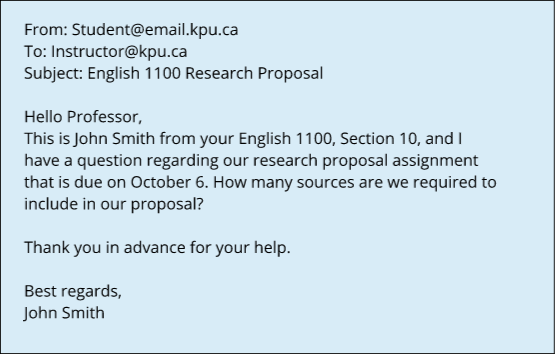1.2 – Connect With Your Instructor
Learning Objective
- Identify ways to build a good relationship with your course instructors through in-class, email, and office hour communication.
A key to your success at college is knowing your instructors and what they identify as important in each of your courses. Developing good relationships with instructors involves good communication in and outside of class times. They are available to meet, communicate, and talk with you, but you must plan how to connect with them during their available times. It is part of an instructor’s job to talk to learners outside class, and most successful learners take advantage of that option. It is your right to visit instructors during office hours and discuss any problems or concerns that you have in their course.
In-Class Communication
To build your relationship with your instructor in-class, consider ways that you can show your interest in the course material. Some ways to do this are:
- Listen actively during class to determine what is most important to the instructor.
- Avoid arguing with the instructor. If you disagree with something said in class, try to ask questions about the topic after class.
- Read the textbook before class and prepare questions to ask.
- Let your instructor know what interests you about the course.
Communicating in Office Hours
Instructors hold office hours outside of class. Whenever possible, try to meet your instructor during these times. You can use office hours to ask questions about the course material, to get clarification about the requirements for an assignment, or to learn more about a topic from the class that you find particularly interesting. Some tips for using office hours effectively:
- Arrive on time to be respectful of your instructor’s and other students’ time.
- Come prepared by bringing your textbook and other course materials.
- Prepare questions ahead of time.
- Summarize key points to make sure you understand.
Communicating By Email

Instructors often receive many e-mails from students. To write an effective e-mail, consider the following:
- Use your university e-mail account when possible.
- In the subject line, write the course name and topic of your email
(e.g. BIOL 1100 Lab Report 2). - Use a professional greeting in the e-mail (“Dear” rather than “Hey!”).
- Write your question or concern in short, clear sentences.
- End your e-mail with an appropriate conclusion (e.g. “Thank you in advance for your help”, or “Thank you for your time and consideration”).
- Allow time for your instructor to respond – don’t expect an instant reply.
By showing an interest, taking time to communicate with your instructor throughout the course, and using e-mail effectively, you will be well on your way to building a good relationship that will support your communication and learning. [1]
Try It!
If you have already reviewed your course presentation, you will know when and where you can contact your instructor during office hours. Plan to drop by your instructor’s office hours this week. If you don’t yet have a question to ask, consider having a brief conversation with your instructor about one of the following topics:
- What is one thing I can do to / be successful in this course?
- How do the concepts I will learn in this class connect with other courses I will take in the future?
- What can I do to improve my class participation/ writing/ presentation skills?
- What interests you most about your field?
Attribution & References
Except where otherwise noted, this chapter is adapted from ” Connect with your Instructor” In University 101: Study, Strategize and Succeed by Megan Robertson, Kwantlen Polytechnic University Learning Centres licensed under CC BY-SA 4.0. / Adaptations include small edits to improve student-friendly language, and formatting. Accessibility updates also included.
- Study Guides and Strategies. (n.d.). Influencing teachers and improving classroom communication skills. Retrieved from http://www.studygs.net/attmot2.htm ↵ ↵

